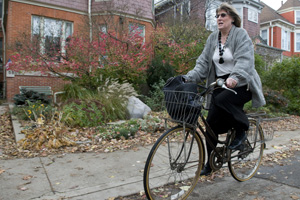Biking adds to a healthy lifestyle, subtracts from costly commute
By Greg Borzogregborzo@uchicago.edu
News Office
 Photo by Dan Dry Constantin Fasolt, the Karl J. Weintraub Professor in History and the College, rides to campus on a 30-speed, carbon-frame steed, complete with body gear to protect him from the elements. |
|
 Photos by Lloyd DeGrane Dave Miller | |
 Kitty Mann | |
On one of Mary Blumer Reed’s first days as a University Hartford Fellow, she was surprised to see one of her teachers ride off on a bike after breakfast at the Quad Club.
“I found it encouraging that a professor was taking into account the environment, her health and community spirit,” said Blumer Reed, who earned her A.M. from the School of Social Service Administration this year. “That made her very approachable and told me something about her values.”
Indeed, the teacher, Kitty Mann, Adjunct Instructional Staff in the School of Social Service Administration, bikes because it simplifies her life, saves time and money, provides regular exercise, reduces stress and protects the environment. These are the same sentiments that motivate a large and growing number of faculty and staff to bike to work—despite the increasingly inclement weather.
These shared motivations, however, do not necessarily lead to similar approaches to bicycling. Some ride clunkers, others expensive imports; some bike year round, others only in the summer. Most ride all the way to work, others part of the way, taking public transportation the rest of the way. Some bike only a few blocks, others many miles.
David Miller, Manager of the Social Sciences Division Business Center, has logged thousands of miles over the 13 years he’s been biking to campus. His commute is now 10 miles each way, and he rides virtually every day, which adds up to 5,000 miles a year. “Since the earth’s circumference is 25,000 miles, I circle the earth every five years,” he said.
Miller currently rides a simple road bike that he saved from the trash and refurbished for $150. He finds that biking helps relieve stress.
At the other end of the spectrum, in terms of equipment, is Constantin Fasolt, the Karl J. Weintraub Professor in History and the College, who rides a $2,500 carbon-frame steed with 30 speeds. His previous bike, which had a similar value, was stolen from its parking space in front of Harper Memorial Library on the first day he rode to campus in September. He keeps the new bike in his office.
Robert Griffith, Senior Project Manager for Networking Services and Information Technologies, doesn’t have to worry about his bike being stolen; not on campus, anyway. He bikes a couple miles to the Homewood Metra station and then takes the train the rest of the way to work. His only problem is that the Metra bike racks are extremely crowded during the summer and fall.
Griffith is thinking of bringing a second set of wheels to use around campus, especially since NSIT’s renovation of the Illinois Bell Telephone Building at 6045 S. Kenwood Ave., will include indoor bike storage and two shower rooms, once it opens in January. The bike facilities helped the building earn Leadership in Energy and Environmental Design certification. “We were going for Silver but may get Gold certification,” said Alex Henson, Executive Director of NSIT.
Melissa Roderick, the Hermon Dunlap Smith Professor in the School of Social Service Administration, commutes about 14 miles a day on her 18-speed Bianci road bike, but only in good weather.
During her 18 years of biking to the University, she has seen ridership increase threefold, which leads to crowded bike racks and paths. “I don’t like all the crowds; it’s like ‘bumper bikes’ on the lakefront path,” she said.
Nevertheless, Roderick carries tools and inner tubes to help fellow riders along the way. “I’ve rarely come across University of Chicago cyclists who need help,” she noted. “Perhaps they’re better prepared than other cyclists.”
Her biking benefits co-workers, too. “When we have a tough problem to resolve, someone will ask me, ‘Are you riding to work tomorrow?’ because they know that if I am riding, I’ll have the problem figured out by the time I arrive the next morning,” she said.
Most bicyclists are amused by how colleagues and students react to their riding. “Some perceive this as weird; others are in awe,” Roderick said.
“I know that some people are inspired by our example,” Griffith added.
Mann doesn’t really care what others think. She began biking to the University when she was a graduate student and was amused a few years later by something one of her faculty advisors said.
“Once when we were doing an assessment of an elderly woman, the team agreed that the fact that this woman wore a skirt while biking was a sign of being ‘unstable.’”
Twenty years later, Mann still enjoys riding her bike around campus—especially while wearing a skirt.
![[Chronicle]](/images/sidebar_header_oct06.gif)